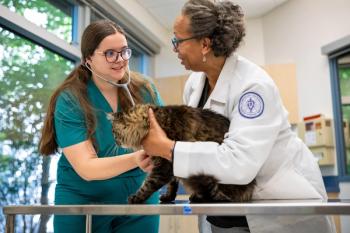
The Association Between Leptin, Lipids, and Canine Gallstones
Researchers have identified an association between canine gallstones and elevated serum leptin levels and hyperlipidemia, providing new insight into canine gallstone pathophysiology.
Cholelithiasis is the presence of gallstones within the gallbladder or hepatic ductal system. Canine gallstones, which are largely composed of calcium bilirubinate, typically cause no clinical signs and are identified incidentally on abdominal ultrasound. These gallstones can become life-threatening, though, if they become lodged in the common bile duct.
Three potential factors contribute to gallstone development: gallbladder hypomotility, mucin hypersecretion, and disrupted gallbladder absorption/secretion. Interestingly, human and animal studies have reported a relationship between leptin, a protein hormone, and the gallbladder. For example, leptin regulates genes responsible for gallbladder motility and normal secretion/reabsorption activities. In addition, the canine gallbladder produces leptin. To date, though, the relationship between leptin and canine cholelithiasis has remained largely unknown.
In a study recently published in
RELATED:
- Canine Urinary Microbiome Analysis Challenges Long-Held Assumptions
- Ovariohysterectomy: Be Prepared for Abdominal Surgery
Sample Collection and Analysis
Researchers evaluated 34 dogs with gallstones and 28 healthy dogs, each with normal body condition scores. Fasting blood samples were collected to measure serum triglyceride, total cholesterol, glucose, and insulin levels; serum leptin levels were measured using ELISA.
Gallbladder samples were collected from dogs with gallstones who underwent cholecystectomy and healthy control dogs euthanized for nonstudy reasons. Researchers then performed real-time polymerase chain reaction testing to measure mRNA expression of leptin and its receptor.
Results
Dogs with gallstones were significantly older than healthy dogs (12.5 vs 8 years old). Of the 34 dogs with gallstones, 7 had diabetes.
Serum Measurements
Serum leptin levels were significantly higher in the gallstone group than in the control group, and in the dogs that underwent cholecystectomy than in those that did not. These findings “suggest that serum leptin levels may represent an additional useful biomarker for the assessment of the severity of [canine] cholelithiasis,” the researchers wrote.
Levels of serum total cholesterol, triglyceride, and insulin, but not glucose, were also higher in the gallstone group.
Within the gallstone group, researchers analyzed serum leptin and insulin levels in dogs according to the presence of diabetes; diabetes, the researchers noted, contributes to cholesterol hypersecretion and is a major risk factor for gallstones. In this study, concurrent diabetes did not significantly affect serum leptin or insulin levels. This finding aligns with previous studies reporting little association between leptin and diabetes in dogs.
Expression Levels
Leptin and leptin receptor gallbladder expression levels were significantly upregulated in the gallstone group compared with the control group.
Correlations
In both study groups, serum leptin was positively correlated with serum total cholesterol and triglycerides, but not insulin, glucose, or other demographic factors. Odds ratio calculations indicated that hypercholesterolemia and hypertriglyceridemia significantly increased cholelithiasis risk.
Cholesterol hypersecretion into the bile, the researchers explained, creates biliary sludge and and reduces gallbladder motility. Hypertriglyceridemia can reduce sensitivity to cholecystokinin, a neurotransmitter that triggers gallbladder contractility, and decrease motility. This hypomotility is a potential contributing factor to cholelithiasis.
Bringing It Together
The researchers concluded that a homeostatic imbalance and increased levels of leptin and lipids (cholesterol or triglycerides) contribute to cholelithiasis, and that upregulated expression of leptin and its receptor is an attempt to restore gallbladder homeostasis. Additional studies, they noted, will be needed to further examine the relationship between leptin, hyperlipidemia, and canine cholelithiasis.
Dr. Pendergrass received her Doctor of Veterinary Medicine degree from the Virginia-Maryland College of Veterinary Medicine. Following veterinary school, she completed a postdoctoral fellowship at Emory University’s Yerkes National Primate Research Center. Dr. Pendergrass is the founder and owner of
Newsletter
From exam room tips to practice management insights, get trusted veterinary news delivered straight to your inbox—subscribe to dvm360.





